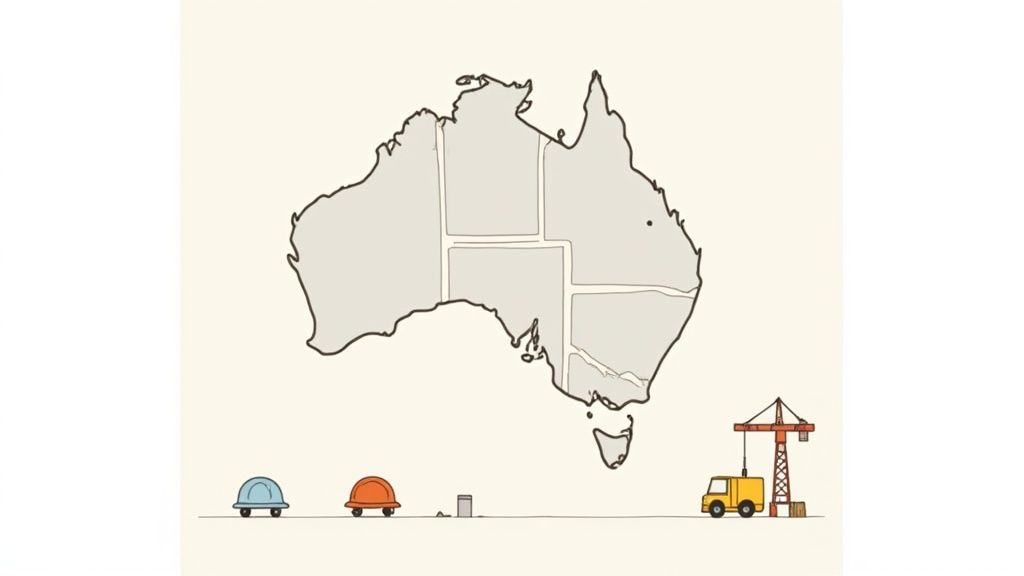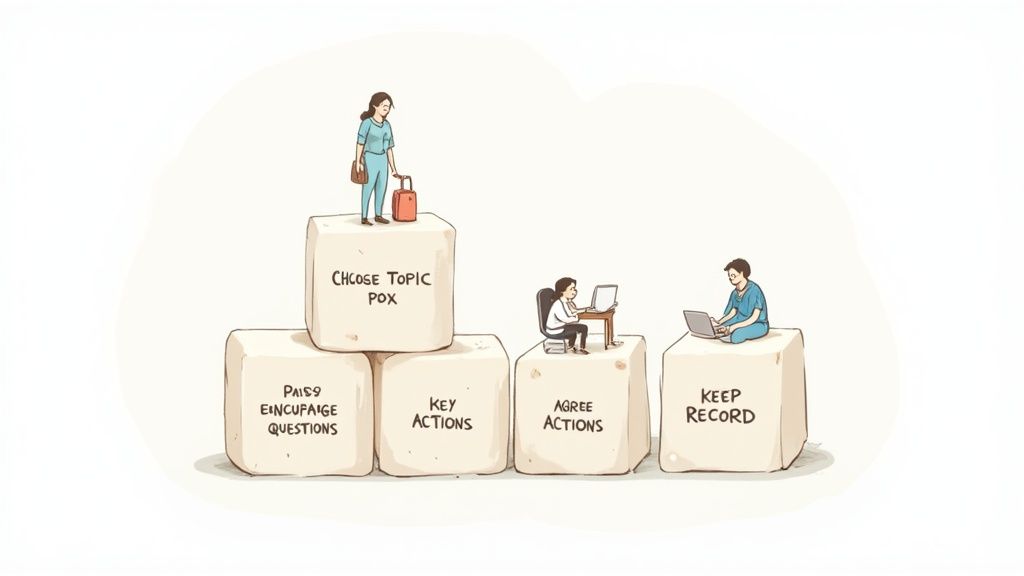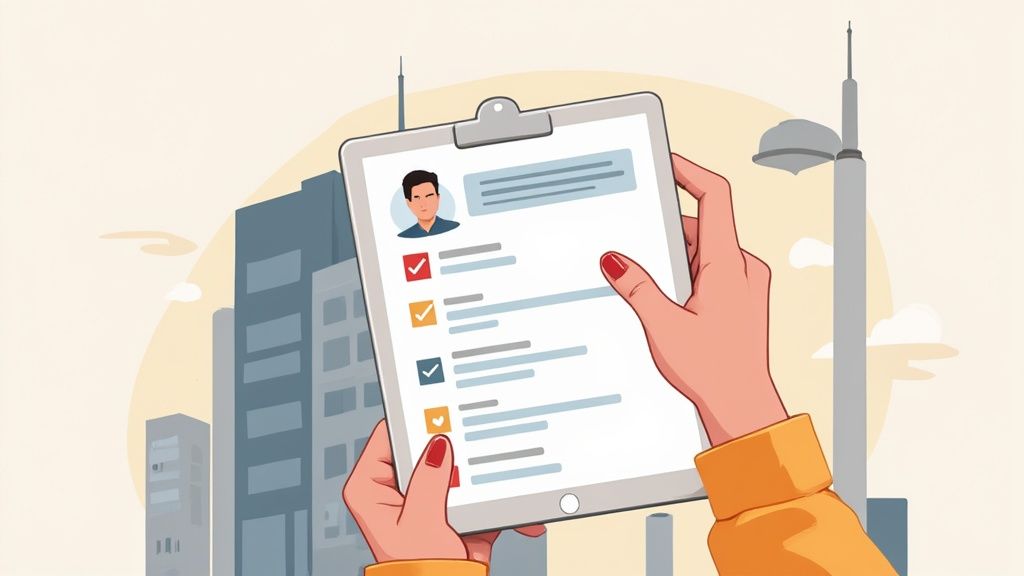Ever heard of a toolbox talk? If you've spent any time on a worksite, you've probably been part of one without even realising it. Think of it as the pre-game huddle for a work crew, a quick, informal safety chat that happens right on-site before the day’s work kicks off. It’s not a lecture; it's a practical, on-the-spot conversation to get everyone focused on the real hazards they’ll be facing that day.
What Is a Toolbox Talk in Plain Language?
Let’s cut through the jargon. At its heart, a toolbox talk is just a simple, effective communication tool.

It’s a brief, direct chat, usually led by a site supervisor or team leader, that zones in on a specific safety topic relevant to the tasks ahead. The name comes from the old-school image of workers gathering around the toolbox for a quick briefing before grabbing their gear.
The real goal here is to put immediate safety issues front and centre. Forget stuffy classroom training sessions. These talks happen right where the action is, which means the information is instantly relatable and easy to apply. This practical approach bridges the gap between the general safety rulebook and the specific, ever-changing challenges of a live job site.
Here in Australia, toolbox talks are widely recognised as a smart and effective way to meet Work Health and Safety (WHS) obligations. They’re quick, they’re focused, and they usually last just 5 to 15 minutes. You’ll see them happen right before a shift starts or just before a particularly high-risk job gets underway. Industry experts like those at Safer Outcomes highlight how crucial these talks are for maintaining WHS compliance on Australian worksites.
Toolbox Talk Key Features at a Glance
To put it simply, here’s a quick breakdown of what makes a toolbox talk what it is.
| Characteristic | Description |
|---|---|
| Duration | Short and sharp, typically 5-15 minutes, to hold everyone's attention. |
| Location | Held on-site, right in the thick of it, whether that's a construction site or a factory floor. |
| Topic | Focused on a single, specific hazard or task that's relevant to the day's work. |
| Format | Kept informal and interactive to encourage questions and genuine discussion from the team. |
| Goal | To raise immediate awareness of risks and reinforce the safe work procedures that matter right now. |
Ultimately, it’s all about connecting with the team and making sure safety isn't just an afterthought.
A toolbox talk is fundamentally about communication. It’s the daily check-in that makes sure every person on the job knows the specific risks they will face and exactly how to manage them before the work even starts.
Why Toolbox Talks Are Non-Negotiable on Australian Worksites
On any worksite, it’s often the small, overlooked risks that turn into major incidents. Toolbox talks are more than just a morning ritual; they're a practical tool designed to stop accidents before they can start. They cut through the noise and put immediate, relevant hazards front and centre for everyone.

Think of these meetings as your first line of defence against the most common dangers on site. A consistent, daily reminder about topics like working at heights, operating machinery, or managing electrical hazards keeps safety at the forefront of every worker’s mind. It's one of the simplest ways to meet your WHS obligations while actively protecting your crew.
The numbers really drive home how critical this focus is. Over the last decade, workplace traumatic injuries have claimed more than 1,850 Australian worker lives, and over 1.14 million serious compensation claims have been lodged. The fatality rate sits at an average of 1.4 deaths per 100,000 workers, mostly from vehicle incidents, falls, and being hit by moving objects. These are all hazards that a good toolbox talk can directly address. You can dig deeper into these latest WHS statistics yourself.
Building a Habit of Risk Awareness
Running toolbox talks regularly builds a crucial habit: it trains everyone on site to actively spot and manage risks throughout the day. When a supervisor takes a minute to discuss a near-miss from yesterday's shift, it turns a potential mistake into a valuable lesson for the whole team.
A daily toolbox talk makes risk identification a shared responsibility. It gives every person on site the information and opportunity to speak up about a hazard, turning passive awareness into active prevention.
This proactive approach is everything. Instead of just reacting after an incident, these quick chats help teams identify and control hazards before they cause harm. It’s a small investment of time that pays massive dividends in keeping your people safe and your project on track.
The Building Blocks of a Successful Toolbox Talk
A good toolbox talk isn't a lecture; it's a practical, on-the-ground conversation. The real goal is to get a two-way discussion going, not just talk at your team. Following a simple, repeatable framework is the key to making these talks effective without bogging everyone down.

This structure ensures you hit all the important points quickly and efficiently. It turns what could be just another quick chat into a genuinely valuable part of your daily safety routine.
A Simple Five-Step Framework
You can use this exact process for any topic you can think of, from operating new gear to navigating wet conditions on site. It’s designed to be quick, clear, and most importantly, actionable.
- Pick One Specific Topic: Don’t try to boil the ocean. Zero in on a single, relevant hazard or task for that day’s work. Think "safe ladder use" or "spotting trip hazards in Area C," not a general safety overview.
- Present the Key Points Clearly: Briefly run through the risks and the right way to do things. The best way to make it stick is to use real examples from your own worksite.
- Get the Team Talking: This is where the magic happens. Ask open-ended questions like, "Has anyone seen any issues with this lately?" or "What’s the smartest way to handle this on our site?". You'll get incredible insights from the crew who are hands-on with the work.
- Agree on Practical Actions: What will everyone do differently today? Get a consensus on a clear, simple action, like making sure all extension cords are inspected before use or clearing a specific walkway by morning tea.
- Keep a Simple Record: Jot down the date, the topic, who was there, and what was agreed upon. This simple step is absolutely crucial.
Why Documentation Matters
Keeping a record isn't about creating more paperwork; it's about creating accountability. When you write down who attended and the actions everyone committed to, it ensures the whole team is on the same page and gives you an easy way to follow up.
This documentation is a core part of your practical workplace safety training and proves you’re taking proactive steps to keep people safe.
The most effective toolbox talks actively involve workers by recording attendance, documenting discussed hazards, agreeing on corrective actions, and assigning responsibility. This builds trust and encourages workers to keep reporting hazards.
This simple act of documenting turns a quick chat into a verifiable safety action. It creates an ongoing dialogue where workers feel heard and have direct input into making the worksite safer for everyone. You can dig deeper into this process with this excellent guide to toolbox talks from SafeWork NSW.
How to Run Talks People Actually Pay Attention To
Knowing what a toolbox talk is and actually running one that keeps your crew engaged are two completely different things. A talk that falls on deaf ears is a waste of everyone’s time. The key is to be practical, direct, and interactive, turning it from a mandatory briefing into a valuable conversation.
The most common mistake I see is people trying to cover way too much information. Stick to a single, focused topic and keep the entire talk under 15 minutes. Attention spans are short, especially before a long day of work. A brief, punchy discussion on a specific hazard is far more effective than a long, rambling lecture.
Make It Real and Interactive
The best way to get your point across is to make it tangible. Instead of just talking about faulty equipment, bring a damaged grinder lead or a cracked ladder to the talk. Passing around a physical prop makes the hazard real and memorable.
Likewise, use examples from your own worksite. Mentioning a near-miss that happened last week or pointing out a specific trip hazard in the work area connects the topic directly to everyone’s daily reality. It makes the information immediately relevant. The success of any toolbox talk hinges on the participants' ability to effectively retain the crucial safety information presented; explore strategies to improve memory retention to make your points stick.
A toolbox talk should never be a one-way street. The goal isn't just to talk at your crew; it's to get them talking back. The people doing the work often have the best insights into the real-world risks.
Ask open-ended questions to start a real discussion. Instead of asking, "Everyone clear on the ladder policy?", try something like, "What are some of the ladder-related risks you've seen on this site?". This simple change invites participation and turns your team into active problem-solvers. For more topic ideas to get the conversation started, check out this great list of practical safety share ideas that work for any team: https://safetyspace.co/safety-share-ideas
Finally, try to avoid these common pitfalls:
- Don't read from a script: It feels impersonal and boring. Know your key points and speak naturally.
- Choose the right location: Avoid holding talks in loud, distracting areas where no one can hear you.
- Don't just lecture: Encourage questions and make it a genuine two-way conversation.
Bringing Your Toolbox Talks into the 21st Century
Running a great toolbox talk is one thing, but dealing with the mountain of paperwork afterwards? That’s a whole different story. Let’s be honest, shuffling paper forms, deciphering messy spreadsheets, and trying to keep records organised is a massive headache for any worksite.
Moving away from that clutter is a huge step forward. Digital tools don’t just get rid of the paper; they connect your daily talks directly to your wider safety management system, making the entire process simpler and a lot more effective.
Imagine this: a supervisor pulls out their phone or tablet, selects a relevant safety topic from a pre-loaded library, and runs the talk right there. Once it's done, they can capture digital signatures from everyone who attended. It's a clean, efficient process that takes just a few minutes, not half an hour of chasing signatures and filing forms.

The image above gives you a glimpse of how you can manage talk topics and track attendance all in one place. This creates a clean, searchable record that makes compliance a breeze and follow-ups almost effortless.
From Talk to Action
Here’s where a digital approach really shines: handling follow-up actions.
If a worker points out a damaged guardrail during the talk, you can log it as a corrective action right there in the app. No more jotting it down on a scrap of paper and hoping it doesn't get lost. You can assign the task to a specific person, set a deadline, and track its progress until it’s marked as complete. This closes the loop and guarantees important safety issues don’t fall through the cracks.
For those looking to take things even further, you can explore innovative solutions like using augmented reality for workplace safety to make these discussions more visual.
By logging actions and tracking them digitally, you turn a simple conversation into a powerful source of safety data. You can start spotting recurring issues or hazards, giving you valuable insights to prevent future incidents before they even happen.
This approach gives you a clear audit trail and makes compliance reporting much, much easier. A good employee safety app like the one on https://safetyspace.co/employee-safety-app integrates these daily checks into your overall system, providing a real-time view of what's actually happening on the ground.
Ultimately, it organises your safety efforts, ensures accountability, and helps you focus on what really matters: fixing problems before they become serious incidents.
A Few Common Questions About Toolbox Talks
Even when you've got a solid plan, questions are bound to pop up on site. Let's run through some of the most common ones we hear about running a toolbox talk.
How Often Should You Be Running Them?
For high-risk environments like construction or manufacturing, daily talks are the gold standard. It’s the best way to set the tone for the day and tackle any hazards that are immediately relevant to the work ahead.
If you’re in a lower-risk setting, weekly talks might be all you need, or perhaps just before a non-routine job kicks off. The real key here is consistency. Make it a regular part of your work rhythm so everyone knows what to expect and when.
Who Should Lead the Talk?
Most of the time, the site supervisor or team leader takes the lead. It makes sense, they have the clearest view of the day's tasks, the risks involved, and who’s on the crew.
But don’t be afraid to mix it up. Asking an experienced worker to lead a talk on something they’re an expert in is a fantastic way to get everyone more engaged. It shows that safety is a shared responsibility, not just a top-down directive. Plus, it's a great way to build confidence and leadership skills within your team.
A toolbox talk is a chance for real-world expertise to shine. When the person who uses the equipment every day explains the risks, the message hits home much harder.
What if Someone Raises a Serious Safety Issue?
Perfect. This is exactly why you're holding these talks in the first place. If a worker points out a serious problem, like a dodgy piece of equipment or an unguarded edge, it needs your full attention, right away.
If it's not something that can be fixed safely on the spot, work in that area must stop until a proper solution is in place. You need to document the issue, who’s responsible for the fix, and the deadline, then follow up to make sure it’s done. Never, ever brush off a concern raised during a talk. Doing so completely undermines the trust you're trying to build.
Ready to stop juggling paper and start managing safety effectively? The Safety Space platform makes it simple to schedule, run, and document every toolbox talk, ensuring nothing gets missed. Book a free demo to see how it works.
Ready to Transform Your Safety Management?
Discover how Safety Space can help you build a safer, more compliant workplace with our comprehensive safety management platform.
Book a Free DemoRelated Topics
Safety Space Features
Explore all the AI-powered features that make Safety Space the complete workplace safety solution.
Articles & Resources
Explore our complete collection of workplace safety articles, tools, and resources.
